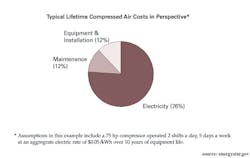When you’re redoing your kitchen, ordering from a place like IKEA sounds like a great idea. You have an endless selection and the price is right, too. Then you bring home that thin cardboard box that is somehow supposed to turn into a sturdy, sleek-looking cabinet. Pull out the 90 or so pieces and nightmarish instructions and you start to think maybe this was a bad idea.
When you’re done a few days and mental breakdowns later, not only are you convinced it was a bad idea, but the cabinet might not look exactly like it does on the box. One door is lower than the other; there are spaces where there shouldn’t be.
Now apply that to a pneumatic system. If you work at an OEM and assemble these for use in manufacturing or packaging, you already know. Assembly and labor are painstakingly long, and air leaks from the dozens of thread joints.
There is another way, thankfully. Just order a customized completed circuit, which is the Amish furniture equivalent to the IKEA-style site-assembled air circuit.
When you hear “custom,” you may think expensive, but this method can actually save money in more ways than one.
After speaking with Pneumadyne, a subsidiary of Bimba Manufacturing that builds everything at their site so all you have to do is a simple installation, we thought of three actually. Here they are:
1. Simplify the Supply Chain
When buying from IKEA, at least all the parts come together. With air circuits, you may have one supplier for tubing, another for the regulators, another for the valves, and so on. This is a plug-and-play system, so there is no need to contact several suppliers, erasing any potential supply chain and logistics headaches.
2. Optimize Energy Efficiency
Implementing a pre-assembled air line eliminates air leakage at the threaded joints, explains John Schmidt, director of operations at Pneumadyne. Improperly sized components and inefficient bends in the line can also lead to wasted energy. Much of this is because the parts system is assembled on-site, then powered up and troubleshooting is done to identify leaks.
They don’t find them all, Schmidt says.
“In typical manufacturing environments, pneumatic systems inherently lose 30-35% due to air leakage from fittings or seals,” Schmidt says.
By designing the whole system themselves, Pneumadyne cuts out the need for threaded joints and can test for optimized airflow prior to shipping to the client.
“We also put the control valves at point of use rather than plumbing at the cabinet and design the valves into the proper location to eliminate unnecessary air runs,” Schmidt says. “That’s where you’re going to really gain efficiency.”
So what does efficiency actually mean to you? Compressed air savings.
Energystar.gov estimates that 30% or more of the electricity consumed in a manufacturing facility comes from compressed air. The site also calculates that the annual energy cost for a 200-hp compressor running for 6,800 hours equates to $51,064/yr.
In this scenario, cutting that air leakage loss to even a conservative 15% saves more than $7,000/yr.
3. Cut Down on Labor and Increase Production
In a site-assembled system using individualized components, the OEM’s workers take these off-the-shelf components, thread the fitting into them, then push pieces of tubing into them. This tubing may have to be cut, which extends the process. After that, they run the air line to the next component and repeat until the circuit is completed. Then you troubleshoot and fix any issues.
Then you move on to the next one. It’s tiring just to imagine it.
Currently, Pneumadyne is working with a medical equipment supplier who took 40 minutes to build one system. Ken Swanson, general manager at Pneumadyne, says the new system being built will cut that down by up to 80%. “With the block we’re creating, just plug in cylinders and be ready to go in 5 minutes,” he says.
Swanson says the labor savings could range from 40 to 80%. That’s because the wages may be higher in New York or California as opposed to Idaho, so the savings may vary.
Production also increases. With the medical supplier, they can now make 96 of these circuits during an eight-hour shift, when before they could assemble only 12.
About the Author
John Hitch
Editor, Fleet Maintenance
John Hitch, based out of Cleveland, Ohio, is the editor of Fleet Maintenance, a B2B magazine that addresses the service needs for all commercial vehicle makes and models (Classes 1-8), ranging from shop management strategies to the latest tools to enhance uptime.
He previously wrote about equipment and fleet operations and management for FleetOwner, and prior to that, manufacturing and advanced technology for IndustryWeek and New Equipment Digest. He is an award-winning journalist and former sonar technician aboard a nuclear-powered submarine where he served honorably aboard the fast-attack submarine USS Oklahoma City (SSN-723).



